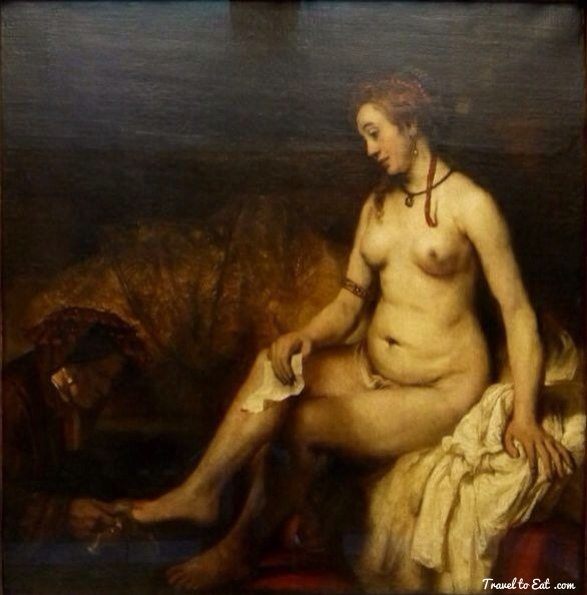
The painting pictured above is the famous “Bathsheba at her Bath” by Rembrandt (1654) hanging in the Louvre. Some think this Rembrandt’s greatest nude. The traditionally accepted identification of the model is of Rembrandt’s partner Hendrickje Stoffels, who would have been 28 at the time of the painting. The intimacy of this portrait is inescapable, she is in her boudior rather than outside, her body is imperfect (hands, belly, breasts) making the onlooker feel the reality of the portrait. Her face has a sense of timeless contentment, or perhaps sorrow at the impending events, something really hard to pull off, reminds me of the enigmatic face of the Mona Lisa. Behind her lies a passage of richly painted drapery composed of browns and ochers that impart a golden warmth. Around her rests a thickly painted background of white chemise; set against this, her naked flesh stands out for its solid form and the amazing application of paint. This portrait was performed by an older man, freed from the lust for pornography, instead painting an intimate reality of his lover.
I could just summarize the story of Bathsheba but I am struck by the beauty of the description of this “booty call” in 2 Samuel 11:1:
1 Then it happened in the spring, at the time when kings go out to battle, that David sent Joab and his servants with him and all Israel, and they destroyed the sonsof Ammon and besieged Rabbah. But David stayed at Jerusalem.
2 Now when evening came David arose from his bed and walked around on the roof of the king’s house, and from the roof he saw a woman bathing; and the woman was very beautiful in appearance.
3 So David sent and inquired about the woman. And one said, “Is this not Bathsheba, the daughter of Eliam, the wife of Uriah the Hittite?”
4 David sent messengers and took her, and when she came to him, he lay with her; and when she had purified herself from her uncleanness, she returned to her house.
5 The woman conceived; and she sent and told David, and said, “I am pregnant.”
The story goes on describe how King David had her husband, Uriah killed and King David took her as one of his wives. Ultimately, they had a son together, the equally famous King Solomon. This is about the most lovely description of a basically tawdry event that I have ever read.

David lost his sexual potency and political clout in old age, and a regency was arranged. In a palace coup, Bathsheba and her adviser Nathan secured the throne for Solomon, even though there was an older, more popular brother who was expected to succeed David. Solomon took the throne, honored his mother, and was advised by her. I would like to add a few more thoughts on the painting. There are three horizontal zones to the painting. At the top, her head is glowing with a crown and pearl earring, suggesting heaven and purity. The middle zone encompasses her body, the rich brocades and the letter, suggesting earthly pleasures and the choice of good vs evil. The bottom is rich in red suggesting lust, the fall from grace and perhaps even the consequences of sin. It is significant that her feet are being washed, recalling associations of Jesus washing the feet of the apostles, suggesting the possibility of redemption. The painting is filled with unspoken metaphors, by now I have sat for longer than I care to admit in the Louvre contemplating its mysteries.

The Rembrandt is displayed next to a painting By William Drost, his ex-pupil and close associate, who only lived to the age of 27 and painted his Bathsheba at her Bath when he was age 21. This was painted in the same year as the rendition by Rembrandt above and the perspective of the age of the artist are obvious. This painting brings Bathsheba to the front, and the form is much more stylized. The woman is younger, the breasts perfect and the sexuality more obvious. Willem Drost’s recognized lifetime output of artwork is very small, while Rembrandt is credited with more than 2,000 paintings and etchings, the majority of which are not signed. Drost was one of Rembrandt’s most talented disciples, so much so that his 1654 painting titled: Portrait of a Young Woman with her Hands Folded on a Book was one of the ones attributed to Rembrandt for more than 300 years. In addition the Polish Rider from the Frick museum has been re-attributed to him. His Bathsheba is beautiful, just not Rembrandt.
The story of Bathsheba has captivated artists throughout the ages. In fact I would say there is a cult of artistic renditions of Bathsheba inspired by the subtle sexuality of Rembrandt.

Jan Massys, 1562

Francesco Hayez, 1827

Frederic Bazille, 1870

Jean-Leon Gerome, 1889

Susan Hayward, 1959

Marc Chagall, 1963

Patricia Watwood, 2012

Finally I have this lovely painting titled “Bathsheba in the Palace” by Frank Dicksee from 1892. This Balsheba appears smugly confident after she engineered her son’s ascent to the throne.

